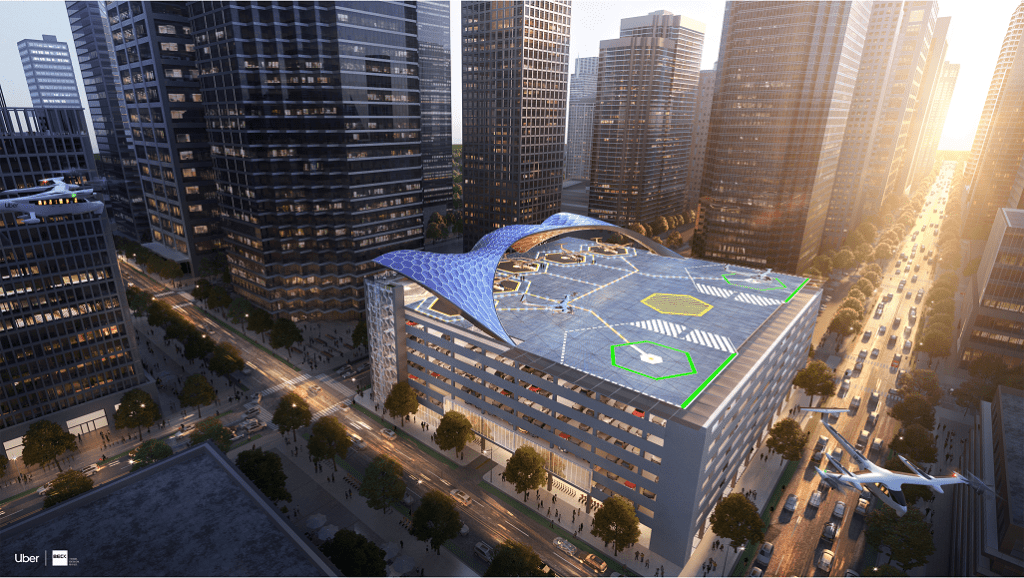
As communities discuss how to prepare for urban air mobility, it’s unclear whether the FAA will have authority over most vertiports. Photo: The Beck Group/Uber Elevate
As communities discuss how to prepare for urban air mobility (UAM), concerns are emerging around how heliports — or future ‘vertiports’ — will be governed by the Federal Aviation Administration.
Companies like Uber are envisioning volumes of traffic comparable to commercial airline operations, which are strictly regulated, but the FAA currently has very little oversight authority over most heliports around the country.
Almost all of the approximately 5,800 helipads in the country are considered private, with the remaining 1 percent — about 60 — listed as ‘public’ heliports, according to Rex Alexander, infrastructure advisor for the Vertical Flight Society.
And even most public helipads are exempt from FAA authority. The agency’s Advisory Circular on heliport design, published in April 2012, states that the FAA “recommends the guidelines and specifications” included within the document, but they are not mandatory except for “projects funded with federal grant monies” through the Airport Improvement Program (AIP), referring to federal grants provided to airports for planning and development purposes.
“Really, only if AIP funding is involved does the FAA have any authority,” Alexander said. “There’s one heliport in the U.S. — which is the Indianapolis downtown heliport — that has ever used AIP funding for construction, redevelopment and repair. One heliport in the entire U.S. where the FAA can actually walk in and say, you have to do this or we’re going to shut you down. The other 5,800 plus — the FAA doesn’t have a leg to stand on.”
When UAM operations scale up toward the volumes envisioned by Uber and other companies that have put forth expansive visions, that lack of oversight may not be ideal. A representative for Uber said the company expects to operate out of both public and private facilities, and is working closely with the FAA to develop standards for future vertiports — a term which the agency does not currently define or use.
“We’re talking about Part 121 volume, commercial passenger transport operations,” Alexander told Avionics International. “When you design and build a heliport or vertiport in the future, we would like to think that the FAA can see something bad and stop it. Right now, if [a vertiport] is designed to be private, the FAA couldn’t do that.”
Local and state authorities have varying degrees of authority and influence over helipads, with zoning rules, fire code and other restrictions applying to their construction, and state legislatures can empower their departments of transportation to provide oversight over UAM operations, according to Alexander. But if there is a federal role for the FAA to play in regulating the expected high volumes of traffic through vertiport operations, ‘public’ and ‘private’ definitions of helipads don’t allow for it.
“The level of authority of future urban air mobility (UAM) infrastructure guidance will depend on the type of funds being used to build such facilities,” a representative for the FAA told Avionics International, confirming that currently only facilities using AIP funds are required to follow FAA guidance. “Future traffic volumes may require further considerations. Recognizing that more work is necessary in this area, we are collaborating with internal and external stakeholders as appropriate.”
To address this new type of high-volume, vertical transit operation, Alexander suggested the FAA adopt a third heliport classification — commercial — which he said the International Civil Aviation Organization (ICAO) currently uses and the Ohio Department of Transportation is considering implementing as well.
Other voices in the industry see the FAA’s criteria for public use heliports as both the problem and solution. Nick Lappos, a senior technical fellow at Sikorsky and chair of a recent report on advanced aerial mobility released by the National Academies Press, explained that current heliport requirements laid out in the advisory circular account for worst-case rotorcraft performance, making it almost impossible to locate public heliports in crowded, urban areas.
“One cure would be to have the FAA and industry develop a set of performance criteria that account for rotorcraft performance, giving credit to rotorcraft with good climb capability and applying that published list to a given heliport’s requirements,” Lappos told Avionics. “We could have Class A, B, and C heliports, matched to Class A, B, C helicopters and future eVTOLs.”
“Establishing FAA heliport/vertiport criteria that accounts for rotorcraft performance, so that locations closer to buildings and obstructions can be used, would be key to opening up urban locations to rotorcraft operations in the future,” Lappos explained. “This would be just as airplane pilots have to calculate runway length against their aircraft’s capability. After all, airplane runways are not all restricted to favor the poorest-performing airplane. FAR 91 allows the pilot to calculate runway length against airplane performance, allowing many small general aviation airports to thrive.”
Cities, investors and operators looking to lay the foundation for UAM infrastructure in cities like Dallas, Los Angeles and Vancouver sometimes cite lack of clarity from regulators as an obstacle to progress.
In September 2019, the FAA reached out to the developers of new VTOL aircraft for input on design standards for future vertiports, beginning a process that may take 18-24 months to result in a new advisory circular with recommendations for the safe operation of eVTOL aircraft based on size, weight, charging specifications and much more. Once finalized, however, what oversight authority will the agency have?